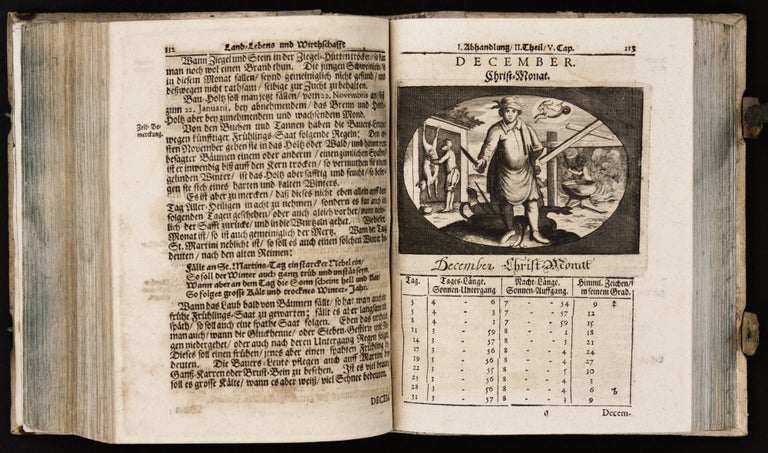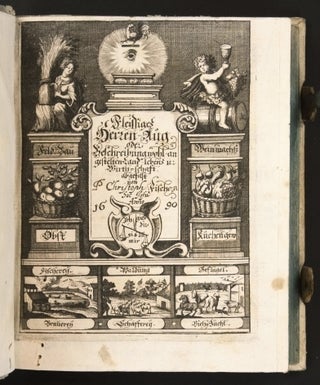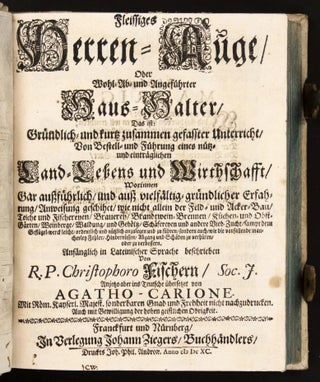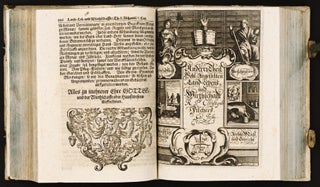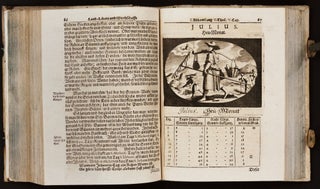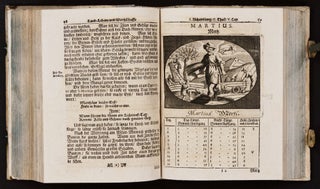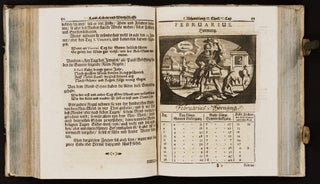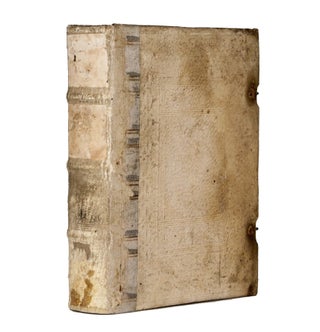Fleissiges Herren-Auge, Oder Wohl- Ab- und Angehführter Haus-Halter ….
4to [21.3 x 15.9 cm], Part 1: (8) ff. (including an engraved frontispiece), 296 pp.; Part 2: (4) ff. (including an engraved frontispiece), 312 pp, with (12) half-page calendrical engravings in the text, with woodcut and initials and tailpieces. Bound in contemporary blind-stamped pigskin over beveled wood boards, retaining metal pins and one of two metal clasps, blue fore-edge. Minor rubbing, staining, and edge wear to spine and boards, scattered worming to lower cover. Manuscript initials ‘ICW’ on lower margin of title page, the occasional minor stain, occasional minor worming somewhat heavier and scattered in the last quires affecting letters of some words but not their sense. Still overall a fresh and pleasing copy. Rare first German-language edition of the Jesuit Christoph Fischer’s (1611-80) comprehensive two-part guide to the management of rural agricultural estates, illustrated with 2 engraved allegorical frontispieces (the meaning of which Fischer discusses in his introduction) and 12 engravings of personifications of the months and here preserved in its fine contemporary binding. The work is a notable example from the genre of Hausväterliteratur, or ‘Household Literature,’ which developed in German-speaking Europe from the end of the 16th century following the success of Johannes Coler’s (1566-1639) Oeconomia (1593). “Hausväterliteratur goes back to medieval guides offering advice to farmers as well as agricultural treatises from Antiquity – above all, works by Cato, Columella and Varro … Under the influence of humanism, the Lutheran Reformation and the revival of the economic teachings of the great thinkers of Antiquity such as Aristotle and Xenophon, the authors of Hausväterliteratur sought to systematize and update the body of knowledge that had been recorded in these writings” (Meyer, p. 222). The two-part Fleissiges Herren-Auge, originally published in Latin as Pars Prima Decas Georgica X (1679/83), is somewhat unusual in that it derives not from a Protestant, but from a Catholic context, with the Jesuit Fischer having developed an expertise in estate management by directing the holdings of the University of Prague for some 33 years (see De Backer). Fischer mixes a vivid literariness derived from Vergil’s Georgics (exploiting a register likely to be appreciated by the educated owners of landed estates who were the intended readership of the compendium) with a very modern emphasis on the precise record-keeping and hand’s-on management skills required to navigate Europe’s increasingly complex bureaucracies. An obvious demand for this (more practically oriented) vernacular edition was apparently already anticipated by Fischer in his Latin edition, given that he appended to it an extensive Latin-Czech-German glossary to help unsteady Latinists with unusual agricultural terms. The first part of the Fleissiges Herren-Auge provides point-by-point technical suggestions about attending to the produce of a rural estate, including sections on tending fields (agrimensorial matters, crop rotation, fertilizing, etc.), fishponds (with a ‘fishing forecast’ based on moon phases, dealing with fish sickness, etc.), brewing beer (and brandy), tending vegetable gardens (including beekeeping), orchards (apple, pear, quince, mulberry, fig, nut trees), viticulture and winemaking, forests and woods (with comments on carpentry and sculpture), animal husbandry (sheep, oxen, milk cows, pigs), and fowls (including keeping pigeons). Fischer notes that his suggestions are based on the climate of Bohemia and the German-speaking ‘Lands of the Bohemian Crown,’ and that readers elsewhere should be aware of this. (It is intriguing to realize that Fischer’s blueprint for establishing rural estates dates from the very decade that German migration to North America began in earnest, although the vicissitudes of plantation economies in the Americas during the colonial period would certainly prove to be quite different from those in Bohemia.) Part Two is devoted to administration, with much advice on record keeping, managing tenants and staff, property rights, land usage laws, deeds, taxes, accounting, and how to run the supporting workshops of the estate (blacksmiths, linen and flax weavers, etc.). Fischer gives considerable attention to organizing the landowner’s physical office, even discussing paper, parchment, ink, quills, blotters, scissors, hourglasses, and proper lighting. A deluge of paperwork can be overcome by building Fischer’s 47-cubbyhole organizer, with one slot for each type of document likely to come across your desk (he provides a full-page diagram [p. 21] and a discussion of each category of document). Fischer emphasizes establishing a weekly routine and provides a full calendar of the year – with 12 fine engravings of the personifications of the months – which digests the foregoing information for easy and timely reference. Because well-fed workers are productive workers, Fischer gives tables showing quantities of provisions (bread, meat, fruits, vegetable, salt) required for between 1 and 16 workers for 4-week and 1-years periods. OCLC locates this 1690 edition of Fleissiges Herren-Auge at Berkeley, Smithsonian, and Yale in the U.S. The 1679-83 Latin first edition is held by Yale, Library of Congress, Illinois, Harvard, Stanford, and Iowa. *De Backer & Sommervogel, vol. 3, cols. 751-2; Schoene, 1697; Günz, I, 131; G. Schröder-Lembke, Studien zur Agrargeschichte; K. Faulmann, Im Reiche des Geistes: Illustrirte Geschichte der Wissenschaften, p. 332; T. Meyer, “Cultivating the Landscape: The Perception and Description of Work in Sixteenth- to Eighteenth-Century German ‘Household Literature’ (Hausväterliteratur),” in The Idea of Work in Europe from Antiquity to Modern Times, J. Ehmer and C. Lis, eds., pp. 215-44.
Price: $3,350.00

